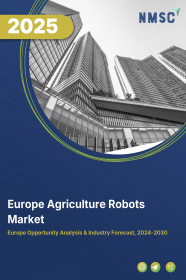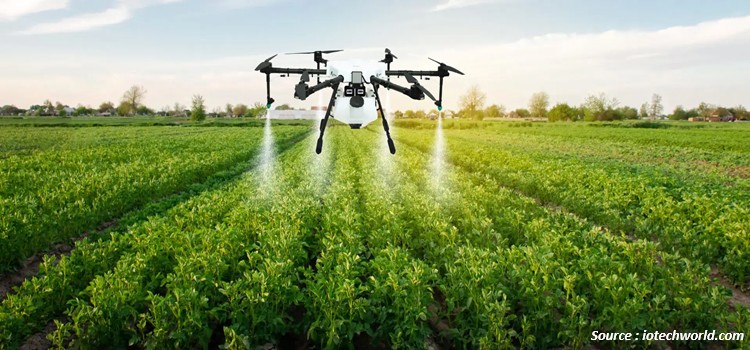
Europe Agriculture Robots Market by Type (Driverless Tractors, Unmanned Aerial Vehicles (UAVs), Milking Robots, Automated Harvest Robots, and Others), Offering (Hardware, Software, and Services), Farming Type (Indoor Farming and Outdoor Farming), Application (Dairy Management, Irrigation Management, Harvest Management, Soil Management, Inventory Management, and Others), and End User (Field Crops, Fruits & Vegetables, and Others) – Opportunity Analysis and Industry Forecast 2023–2030
Industry: Agriculture | Publish Date: 22-Jan-2025 | No of Pages: 217 | No. of Tables: 183 | No. of Figures: 141 | Format: PDF | Report Code : AG619
US Tariff Impact on Europe Agriculture Robots Market
Trump Tariffs Are Reshaping Global Business
Market Definition
Europe Agriculture Robots Market size was valued at USD 1.86 billion in 2022, and is predicted to reach USD 5.42 billion by 2030, with a CAGR of 13.2% from 2023 to 2030. Agricultural robots, also known as agribots or agri-robots, are machines designed to automate or semi-automate various tasks in the field of agriculture. The functionalities of these robots include planting, harvesting, monitoring, and spraying crops.
These robots are developed to improve efficiency, productivity, and accuracy in agriculture while reducing the dependence on manual labor and enhancing working conditions for farmers. They utilize advanced technologies like computer vision, artificial intelligence (AI), and others. Agribots are equipped with sensors, actuators, and intelligent algorithms that enable them to perceive their environment, make decisions, and carry out specific actions. These robots can navigate through fields using GPS or mapping technologies to perform tasks such as planting seeds, harvesting crops, applying pesticides or fertilizers, and monitoring crop health. They use computer vision to identify and differentiate between crops and weeds, detect pests or diseases, and make precise actions accordingly.
The Increasing Adoption of Precision Agriculture
The increasing use of precision agriculture is thereby driving the agriculture robots market growth in Europe. As agriculture robots play a vital role in precision farming by providing precise and targeted operations. With advanced sensors, robotics systems can precisely apply fertilizers, herbicides, and pesticides, optimizing resource usage and minimizing environmental impact.
Additionally, robots equipped with imaging technologies can collect accurate data about soil conditions, crop health, and growth patterns, enabling farmers to make informed decisions and improve overall crop yield. For instance, on March 2023, European Commission launched the Agricultural Robots for Precision Farming. The project is funded by the Horizon 2020 research program, which is the largest research and innovation program in the world. The project will run for four years, until March 7, 2027.
Addressing Labor Challenges and Automation Solutions in Europe
In the agriculture sector of European countries, there are notable labor shortages and rising labor costs. These challenges make it increasingly difficult for farmers to find an adequate workforce and afford the expenses associated with manual labor. However, agriculture robots present a viable solution to address these issues, which is expected to drive the growth of the market.
As agrirobots are designed to automate various tasks traditionally performed by human laborers. They can efficiently carry out activities such as planting, harvesting, crop monitoring, and weed control. By utilizing robotics technology, farmers can reduce their reliance on manual labor and mitigate the impact of labor shortages and rising costs.
High Initial Investment as a Barrier to the Adoption of Agriculture Robots in Europe
One of the main restraints for the adoption of agriculture robots in Europe is the high initial costs involved in the purchase of robotic systems, equipment, and infrastructure. This high initial investment has become a major barrier, especially for small and medium-sized farms with limited financial resources in the region. The cost of acquiring and implementing the necessary technologies can deter farmers from adopting agriculture robots.
Europe Possesses Significant Potential for the Advancements and Innovation in Technology
The adoption of Swarm Robotics, together with AI and sensors, in Europe's agricultural industries is expected to create ample opportunities in the future. As this technology is capable of enabling a swarm of tiny robots to collaborate on activities such as crop monitoring, pollination, and precise spraying. Swarm robotics can improve agricultural productivity, flexibility, and scalability.
Competitive Landscape
The agriculture robots industry includes several market players such as CNH Industrial, Deere & Company, AGCO Corporation, Trimble Inc., Naio Technologies, SZ DJI Technology Co., Ltd, BouMatic, dSPACE GmbH, Ecorobotix SA, Agri-TechE. These market players are adopting various strategies such as new launches to maintain their dominance in the market of Europe.
For instance, in March 2021, the Small Robot Company launched its first robot for pest control. The robot, called Tom, is designed to autonomously navigate fields and identify and kill weeds using a targeted application of herbicide. Tom is the first of three robots that Small Robot Company plans to release in 2023. The company has raised USD 10.7 million in funding to develop its robots, and it has partnered with a number of major agricultural companies, including BASF and Syngenta.
Key Benefits
-
The Europe agriculture robots market report provides a quantitative analysis of the current market and estimations through 2023-2030 that assists in identifying the prevailing market opportunities to capitalize on.
-
The study comprises a deep dive analysis of the market including the current and future trends for depicting the prevalent investment pockets in the market.
-
The information related to key drivers, restraints, and opportunities and their impact on the market is provided in the report.
-
The competitive analysis of the market players along with their market share in the Europe agriculture robots market.
-
The SWOT analysis and Porter’s Five Forces model are elaborated in the study.
-
Value chain analysis in the market study provides a clear picture of the stakeholders’ roles.
Europe Agriculture Robots Market Key Segments
By Component
-
Driverless Tractors
-
Unmanned Aerial Vehicles (UAVs)
-
Milking Robots
-
Automated Harvest Robots
-
Others
By Offering
-
Hardware
-
Software
-
Services
By Farming Type
-
Indoor Farming
-
Outdoor Farming
By Application
-
Dairy Management
-
Irrigation Management
-
Harvest Management
-
Soil Management
-
Inventory Management
-
Others
By End User
-
Field Crops
-
Fruits & Vegetables
-
Livestock
-
Others
Key Players
-
CNH Industrial
-
Deere & Company
-
AGCO Corporation
-
Trimble Inc.
-
Naio Technologies
-
SZ DJI Technology Co., Ltd
-
BouMatic
-
dSPACE GmbH
-
Ecorobotix SA
-
Agri-TechE

















 Speak to Our Analyst
Speak to Our Analyst





















